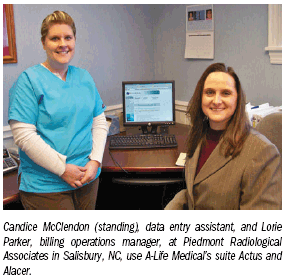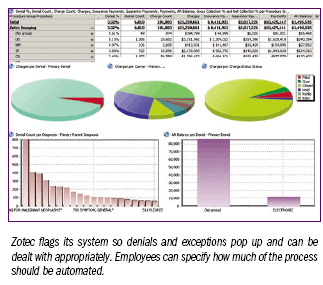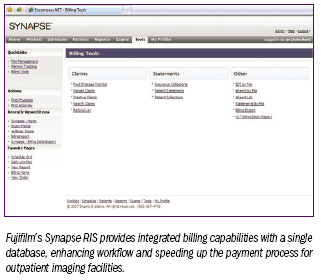Coding and billing applications cut down on staffing, expenses
Before she began using coding and billing computer applications developed specifically for radiology, Yvonne Moncovich, director of operations at Straightline Medical in Wilmington, NC, employed more people, struggled with an import/export function, and manually input data. Usually more than once.
Before she began using coding and billing computer applications developed specifically for radiology, Yvonne Moncovich, director of operations at Straightline Medical in Wilmington, NC, employed more people, struggled with an import/export function, and manually input data. Usually more than once.
But ever since her facility installed Fujifilm Medical System's Synapse RIS, life has become much easier, she said.
Fujifilm's product has a single database for RIS, PACS, and billing. Therefore, information like patient demographics, insurance card images, the referring physician's order, and the radiologist's report is all in one place. Because the product increases efficiency and cuts down on data entry, radiology firms can reduce the number of full-time employees they retain.
Fuji is not alone in its ability to help radiology practices cut labor costs. In fact, all the coding and billing software companies make the same claim, including Charlotte , NC-based IMAGINEradiology. One of Imagine's clients said it was able to cut 2.5 positions due to improved workflow and efficiencies.
"I have also been able to enhance positions by adding additional tasks to employees who before had a full workload, which has cut my payroll down significantly," said Nancy Holland from High Point Radiology in High Point, NC.
Another company that IMAGINEradiology frequently partners with, A-Life Medical based in San Diego, offers a billing and coding system that also saves firms time and money.
"A-Life coding and billing software has aided our radiology practice by decreasing our charge entry lag to two days," said Lorie Parker, billing operations manager at Piedmont Radiological Associates in Salisbury, NC. "It has increased the number of charges by 2% over the prior year. The practice experienced an 80% cost savings with the reduction in staff after the implementation of A-Life."
WHAT CAN SOFTWARE DO?
Billing and coding software falls into one of two camps. Coding and billing are either combined in one application, or they are separate.

In Fuji's case, the applications are combined. The Synapse is RIS-driven, so all the data are captured up front.
"All of the data that are needed and required to submit a claim for reimbursement are completed up front prior to the patient even walking in the door for the examination," said Mark Hilborn, director of Fujifilm's Synapse Information Systems.
When it's time to submit a claim, the employee acts more like an auditor because there is no need to retrospectively gather data. Rather, the data need merely to be looked over, he said.
Fuji's product also generates claims, posts payments, aids in collection management, captures credit card copays, conducts online eligibility verification, and creates management reports.
Another coding and billing software application company, Zotec Partners of Carmel, IN, has a radiology information system, like Fuji, but its product is called the Electronic Billing Center (EBC). While the billing and coding applications are combined, they can be unbundled so different people have access to each function.
The coding piece is taken care of by a product called EBC Data Capture, which takes different modality formats from the hospital and transcription systems and puts them together in a meaningful workflow.
"We're able to piece it together so when the report comes in, it matches the demographics in the profile. And then it presents in a split-screen window so the coder has access to all the demographic information on the left-hand side as well as the report on the right-hand side," said Mark Isenburg, Zotec's vice president of business development.
The coder reviews what was dictated in the body of the report and then puts in the appropriate ICP9 codes as well as the appropriate CPT codes. The system also shows denial probabilities as they relate to a particular client. For instance, if a patient is with Blue Cross Blue Shield and goes in for a CT of the head, Data Capture can determine that 20% of claims from this combination have been denied. The coder can then decide to use the code that is least likely to be denied, according to Isenburg.
Data Capture also codes reports and completes all the data entry elements, cross-referenced from the hospital. The product then links the information to the billing system, and puts it through a series of edits to make sure all required fields are filled and the claim is as thorough as possible. Zotec files and maintains interfaces in 45 states for a majority of carriers, according to Isenburg.
Once the claims are filed, an employee can determine the next step, which-if all goes well-is designed to help billing workflow. An employee can also specify how much or how little should be automated.
Zotec automates phone calls and features a patient portal on the web that allows patients to ask questions, update their insurance information, and make a payment, which will be automatically posted.
Telephone calls save Zotec money because next to labor, the second biggest cost in this process is postage.
"You're thinking about 55 cents or so for every statement or letter that goes out. You can make a phone call for two, three cents maybe, depending on long distance and length of message," Isenburg said.
Though the data entry piece is taken care of by Data Capture, much of the coding is left to humans because Zotec deems the process too complex and delicate for computers. IMAGINEradiology, on the other hand, utilizes computer-assisted coding.

Imagine uses Auto Coder, which can scan an explanation-of-benefits document and pick up all the codes with 60% to 90% accuracy, according to IMAGINEradiology vice president of sales Frank Hayes.
"Now you have effectively reduced somebody having to key in 60% to 90% of those 200 pages, eight to 10 payment lines per page. That's the kind of productivity we provide [with] our technology," Hayes said.
Auto Coder is good for easy high volume/low reimbursement charges. Auto Coder teaches the system how to do the coding, and only the reports it can't code will pop up as exceptions. Auto Coder thereby reduces the amount of time an employee spends coding, and, in addition, an employee can specify how much he or she wants Auto Coder to take care of automatically, according to Hayes.

As a complement to Auto Coder, IMAGINEradiology has a document management system called trueICE, practice management software, and billing software called Imagine Appliance.
While Imagine Appliance is mostly automated, it will flag exceptions or denials for nonautomated intervention.
"Imagine Appliance's purpose is to take the denial, go get the payment from the clearinghouse or from the insurance providers, bring them into the system, post the payments that it can, and leave the exceptions for someone to work out in the morning when they come in," Hayes said.
A-Life Medical has two different products, one specifically for coding (Actus) and one for billing (Alacer). The codes come directly from patient documentation and are routed to the appropriate people. When complete, they are then exported to the billing system. Alacer turns the codes into charges and then applies various scrubbing actions to ensure the claim is clean.
PERSONALIZED CODING AND BILLING
A-Life Medical allows for personalization when it comes to coding and billing. Actus, the coding software, can be set up so an employee can choose the types of codes he or she would like sent directly to billing.
"The employee can configure which codes [to automate] based on analysis and reports that show which coding has the highest accuracy and is the most compliant. So that gives them the information they need to make those decisions," said Mark Morsch, A-Life Medical vice president of natural language processing and new technology.
The electronic feeds are also automated and essentially eliminate data entry. Alacer can import an explanation of benefits into the system to reduce data entry time. Much like with Actus, an employee can set up preferences on Alacer to automatically apply certain rules.
Each coding and billing application has its own unique features. Fuji offers one database for RIS, PACS, and billing. The single database eliminates any need for an HL7 interface between separate applications, which is important from a time, cost, and support point of view, according to Hilborn.
"Being able to access required information via a single click provides inherent efficiencies," he said.
The Synapse RIS was developed by radiology billers with experience of the process.
"I've worked in so many systems [where] I wondered whether the person who put it together had ever even billed a claim. You're sitting there going, 'Why would they think this would work?'" Moncovich said. "The Synapse RIS billing module was designed with billing people."
Zotec's claim to fame is automatically generating appeals and appeal packages. Built into the system is a series of forms that can be prepopulated with the patient's information to create an appeal package. For instance, every time more information is needed by Blue Cross Blue Shield, the software will automatically produce, without any human intervention, an appeal package with all the patient's information ready to be mailed out.
"In this day and age, really your labor is spent on following up the 20% to 30% of healthcare claims that need attention and don't get paid or don't get paid appropriately. So if we can start whittling away at that systematically and make sure everything is being done consistently, then we have a huge advantage at a cost that is more competitive," Isenburg said.
What's unique to IMAGINE-radiology is the emphasis on new technology. The company was the first to offer an application on the iPhone.
"If an administrator is in a meeting, he can press an app on his iPhone, [and] it calls over the Internet to the Imagine server. The Imagine server calculates in real-time the key performance indicators of where things stand and then sends it back to the phone," Hayes said.
Imagine also plans to use voice-over-IP to make telephone calls so the patient's records and any other information can be pulled up on the screen when the call is placed.
A-Life Medical stands out based on its level of automation, according to Morsch. Through the coding process, 70% of reports can be automated. The products also have real-time monitoring to satisfy both small and large organizations. Plus, their technology can be embedded within other billing or radiology information systems.
The other systems can submit securely over the web in real-time a radiology report, run it through the coder, and return the coding back to the system.
"It allows another vendor, another system to utilize natural language processing coding but keep the same workflow they're doing now," Morsch said.
Regardless of the system, customers agree work has become more efficient since the advent of coding and billing applications.
"I've been frustrated by other systems not allowing me to get what I want. So I love being able to not only drill down to the information I need, but to then be able to give my practice the actual data, to say, 'Here it is!'" Moncovich said.
New Collaboration Offers Promise of Automating Prior Authorizations in Radiology with AI
March 26th 2025In addition to a variety of tools to promote radiology workflow efficiencies, the integration of the Gravity AI tools into the PowerServer RIS platform may reduce time-consuming prior authorizations to minutes for completion.
The Reading Room: Artificial Intelligence: What RSNA 2020 Offered, and What 2021 Could Bring
December 5th 2020Nina Kottler, M.D., chief medical officer of AI at Radiology Partners, discusses, during RSNA 2020, what new developments the annual meeting provided about these technologies, sessions to access, and what to expect in the coming year.
Study Explores Impact of Insurance on Treatment and Referrals for Patients with Uterine Fibroids
February 19th 2025Women with uterine fibroids and Medicaid coverage are significantly more likely to be treated with uterine artery embolization than those with commercial insurance, according to newly published research.